26 Baroque Architecture
The highly theatrical Baroque architectural style dominated Italy in the 1600s.
Learning Objectives
Define the characteristics and examples of Roman Baroque architecture
Key Points
- Baroque architecture was linked to the Counter-Reformation, celebrating the wealth of the Catholic Church. It was characterized by new explorations of form, light and shadow, and dramatic intensity.
- Bernini was the master of Baroque architecture in Rome; St. Peter’s Square was one of his greatest achievements.
- Carlo Fontana became Rome’s leading Baroque architect following Bernini’s death in 1680.
- Other influential Baroque architects in Italy included Carlo Maderno, Pietro da Cortano, and Francesco Borromini.
Key Terms
- Counter-Reformation: The period of Catholic revival beginning with the Council of Trent (1545–1563) and ending at the close of the Thirty Years’ War (1648); considered a response to the Protestant Reformation.
- Baroque: A period in western art from c. 1600 to the middle of the 18th century, characterized by drama, rich color, and extreme contrast between light and shadow.
The Baroque Period in Italy
The Baroque period of architecture began in the late 16th century in Rome, Italy. It took the Roman vocabulary of Renaissance architecture and used it in a new rhetorical and theatrical fashion, often to express the triumph of the Catholic Church and the absolutist state. It was characterized by new explorations of naturalism, form, light and shadow, and dramatic intensity.
Whereas the Renaissance drew on the wealth and power of the Italian courts and was a blend of secular and religious forces, the Baroque was – initially at least – directly linked to the Catholic Counter-Reformation, a reform movement in response to the Protestant Reformation. Baroque architecture and its embellishments were on one hand more expressive of the emotions, and on the other, a visible statement of the wealth and power of the Catholic Church.
Architectural Accomplishments
A number of ecclesiastical buildings of the Baroque period in Rome had plans based on the Italian paradigm of the basilica with a crossed dome and nave (cruciform plan), but the treatment of the architecture was very different than earlier examples. One of the first Roman structures to break with the previous conventions was the church of Santa Susanna, designed by Carlo Maderno. The dynamic rhythm of columns and pilasters, central massing, and the protrusion and condensed central decoration add complexity to the structure. There is an incipient playfulness with the rules of classic design, but it still maintains a level of rigor. Look for movement toward the viewer in Baroque architecture in the façade and ornamentation.

Pietro de Cortona
The same concerns with plasticity, massing, dramatic effects, and shadow and light are evident in the architectural work of Pietro da Cortona, illustrated by his design of Santi Luca e Martina (construction began in 1635) with what was probably the first curved Baroque church façade in Rome. These concerns are even more evident in his reworking of Santa Maria della Pace (1656– 8). The façade of the building, with its half-domed portico shadowed with chiaroscuro, and concave side wings, closely resembles a theatrical stage set and projects forward so that it substantially fills the tiny trapezoidal piazza. The conceit of the theater is one of the recurring motifs to look for in Baroque architecture.
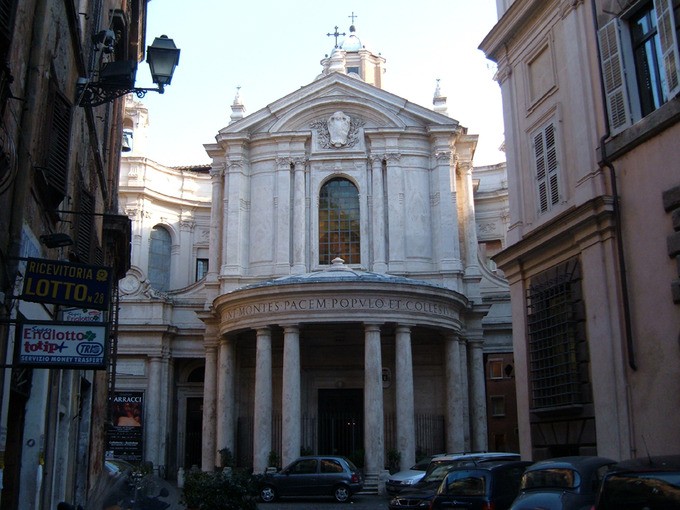
Gian Lorenzo Bernini
Other Roman ensembles of the Baroque and late Baroque period are likewise suffused with urban theatricality and provide points of focus within the surrounding cityscape. Probably the most well-known example of such an approach is Saint Peter’s Square, which has been praised as a masterstroke of Baroque theatre. The piazza, designed by Gian Lorenzo Bernini, is formed principally by two colonnades of free-standing columns centered on an Egyptian obelisk. The oval colonnades extend the façade of St. Peter’s and enclose the piazza in the embrace of Mother Church. Bernini’s own favorite architectural achievement was his oval church of Sant’Andrea al Quirinale, decorated with polychome marbles and an ornate gold dome. His secular architecture included the Palazzo Barberini (based on plans by Maderno) and the Palazzo Chigi-Odescalchi (1664), both in Rome.

Francesco Borromini
Bernini’s rival, the architect Francesco Borromini, produced designs that deviated dramatically from the regular compositions of the ancient world and Renaissance. His building plans were based on complex geometric figures, his architectural forms were unusual and inventive, and he employed multi-layered symbolism in his architectural designs. His iconic masterpiece is the diminutive church of San Carlo alle Quattro Fontane, distinguished by a complicated plan that is partly oval and partly a cross, giving it complex convex-concave wall rhythms. The oval is to Baroque what the rational circle was to the Renaissance. Both Bernini and Borromini make expressive use of the oval in their designs.


Carlo Fontana
Following the death of Bernini in 1680, Carlo Fontana emerged as the most influential architect working in Rome during the Baroque period. His early style is exemplified by the slightly concave façade of San Marcello al Corso. Fontana’s academic approach, though lacking the dazzling inventiveness of his Roman predecessors, exerted substantial influence on Baroque architecture both through his prolific writings and through the number of architects he trained, who would disseminate the Baroque idioms throughout 18th-century Europe.
Spanish Architecture in the Baroque Period
A particular strand of Baroque architecture evolved in Spain and its provinces and former colonies in the late 17th century.
Learning Objectives
- Identify characteristics of Spanish Baroque architecture, its most famous examples, and how it differs from the art of Northern Europe in the 17th century.
Key Points
- In contrast to the art of Northern Europe, the Spanish art of the Baroque period appealed more to the emotions rather than seeking to please the intellect.
- Some of the most notable examples of Spanish architecture from the Baroque period include the façades of the University of Valladolid (1719) and the western façade of the Cathedral of Santiago de Compostela (1750).
Key Terms
- Herrerian: A style of architecture developed in Spain during the last third of the 16th century under the reign of Philip II (1556–1598) and continued in force in the 17th century, transformed then by the Baroque current of the time.
- Moorish: Of or pertaining to a style of Spanish architecture from the time of the Moors, characterized by the horseshoe arch and ornate, geometric decoration.
- Baroque: A period in western art from c. 1600 to the middle of the 18th century, characterized by drama, rich color, and dramatic contrast between light and shadow.
- Obelisk: A tall, square, tapered stone monolith topped with a pyramidal point, frequently used as a monument.
The Development of Baroque in Spain
Spanish Baroque is a strand of Baroque architecture that evolved in Spain and its provinces and former colonies, notably Spanish America and Belgium, in the late 17th century. As Italian Baroque influences spread across the Pyrenees Mountains, they gradually superseded in popularity the restrained classical approach of Juan de Herrera, which had been in vogue since the late 16th century.
For example, by 1667, the facades of Granada Cathedral (by Alonso Cano) and Jaén Cathedral (by Eufrasio López de Rojas) suggest the artists’ fluency in interpreting traditional motifs of Spanish cathedral architecture in the Baroque aesthetic idiom. In Madrid, a vernacular Baroque with its roots in Herrerian and in traditional brick construction was developed in the Plaza Mayor and in the Royal Palace of El Buen Retiro, which was destroyed during the French invasion by Napoleon’s troops. Its gardens still remain as El Retiro park. This sober brick Baroque of the 17th century is still well represented in the streets of the capital in palaces and squares.

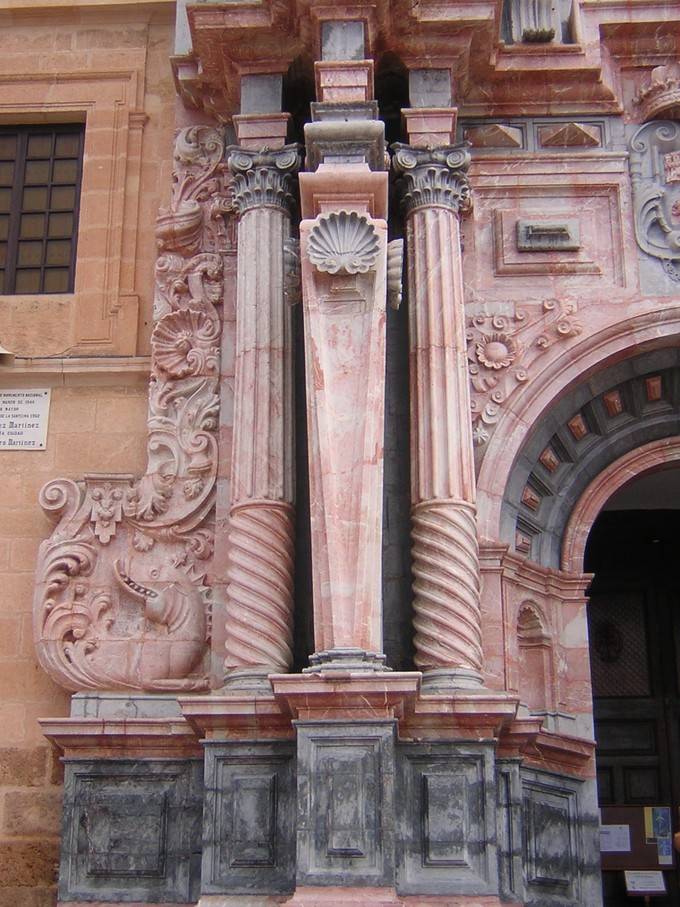
Notable Examples
One examples of the most eye-catching creations of Spanish Baroque is the energetic western façade of the Cathedral of Santiago de Compostela (Fernando de Casas y Novoa, 1750). In this example, as in many others, the Churrigueresque design involves a play of sculptural and decorative elements with little relation to structure and function. The focus of the florid ornamentation is an elaborately sculpted surround to a main doorway. If one removed the intricate maze of broken pediments, undulating cornices, stucco shells, inverted tapers, and garlands from the rather plain wall it is set against, the building’s form would not be affected in the slightest.
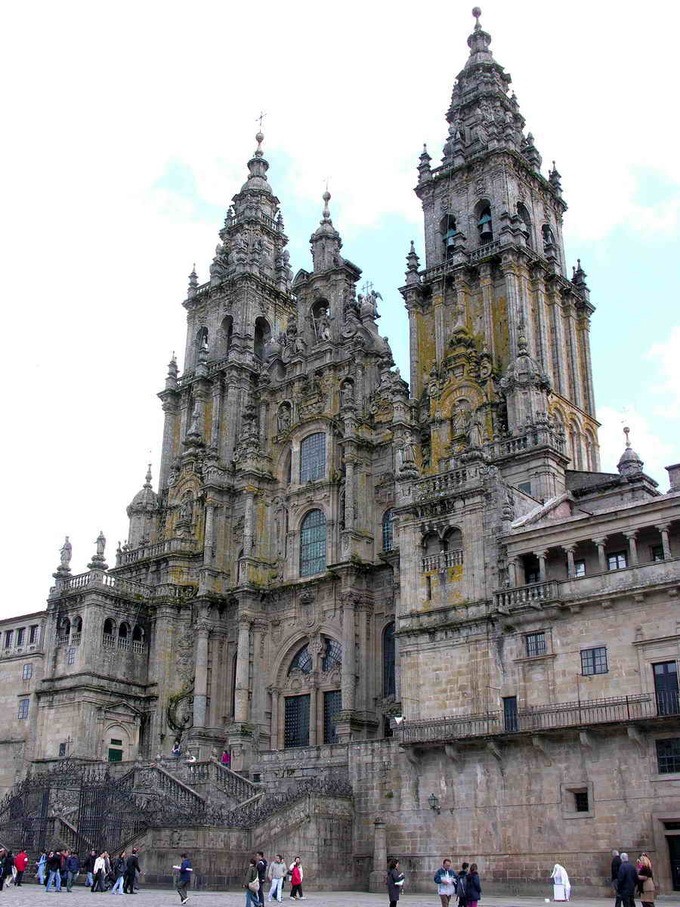
The Royal Palace of Madrid (https://en.wikipedia.org/wiki/Royal_Palace_of_Madrid) deserves special mention. It was constructed in a sober Baroque international style, often mistaken for neoclassical, by the king Philip V.
English Architecture in the Baroque Period
English architecture during the 17th century can be characterized by its use of Palladian, Jacobean, and English Baroque styles.
Learning Objectives
- Define the architecture of 17th century England.
Key Points
- Inigo Jones is known for introducing Palladian architecture to England, a highly symmetrical style based on the principles of formal Classical temple architecture of the ancient Greeks and Romans.
- Popular during the early 17th century, the Jacobean style can be classified by its adoption of decadent and detailed Renaissance motifs such as columns and pilasters, round arch arcades, and flat roofs with openwork parapets, as seen in Hatfield House.
- The architect Sir Christopher Wren was responsible for the genesis of the English Baroque style; after the Great Fire of London in 1666, he rebuilt many of the city’s churches, such as St. Paul’s Cathedral.
- English Baroque architecture can be characterized by heavy structures adorned with elaborate decoration; compared to the contemporary Baroque of the European continent, however, it tends to be relatively plain, with more Classical subtleties.
Key Terms
- arcade: A row of arches.
- parapet: Part of a perimeter that extends above the roof.
- pilaster: A rectangular column that projects partially from the wall to which it is attached; it gives the appearance of a support but is only for decoration.
English Architecture in the 17th Century
The architecture in England during the 17th century saw a continuation of the use of Classical forms, which eventually gave way to a uniform style, derived chiefly from Italy and exemplified predominantly in the work of Inigo Jones. Jacobean architecture was prominent in the first quarter of the 17th century, and English Baroque architecture, a distinctly English take on the Italian Baroque style, became prevalent during the later part of the 17th century following the Great Fire of London.
Inigo Jones and Palladian Architecture
Palladian architecture is highly symmetrical and based on the principles of formal Classical temple architecture of the ancient Greeks and Romans. It was a style seen during the 17th century in England and became truly prominent in the 18th century. Inigo Jones, one of the first significant English architects, is known for introducing the Italian Renaissance style to England. He is responsible for the Queen’s House at Greenwich (1635) and the Banqueting House in the Palace of Whitehall (1622), which he designed based on the work of Palladio, an influential Italian Classical-style architect; its ceiling was painted by Peter Paul Rubens.
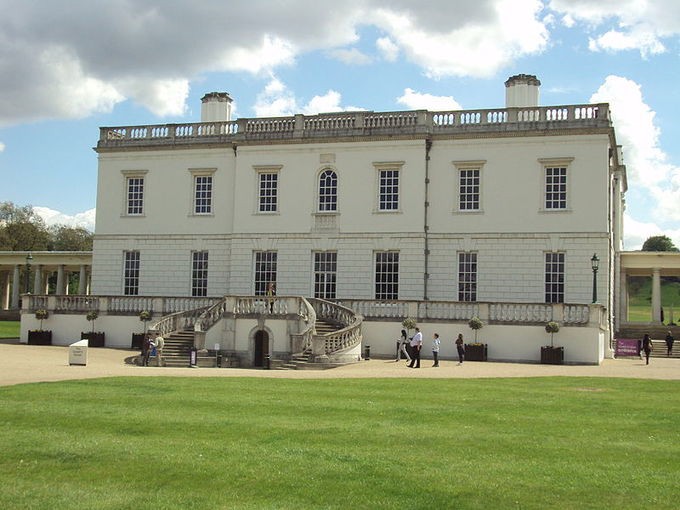
Jacobean Architecture
The second phase of Renaissance architecture in England is termed the Jacobean style. This style was popular during the first quarter of the 17th century during the reign of King James I. Chronologically following the Elizabethan style, the Jacobean style can be classified by its adoption of decadent and detailed Renaissance motifs such as columns and pilasters, round arch arcades, and flat roofs with openwork parapets. These classical motifs were, however, not strictly applied (as they were by Inigo Jones) but used rather freely and synthesized with elements of Elizabethan style architecture. Architectural examples of the style include Hatfield House, Knole House, and Holland House by John Thorpe.
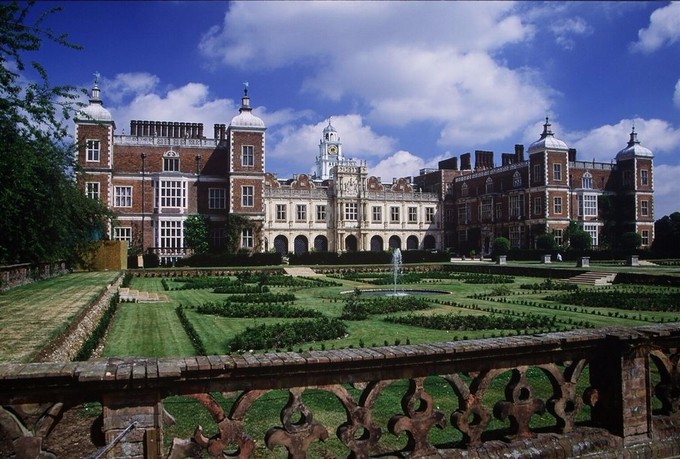
English Baroque
The later 17th century saw Baroque architecture come to prominence in a style that is termed English Baroque. It was the architect Christopher Wren, one of the most acclaimed English architects in history, who was responsible for the genesis of the English Baroque style. When the Great Fire of London in 1666 forced much of the city to be rebuilt, Wren was hired to replace many of the churches. His most ambitious construction, St. Paul’s Cathedral, was a magnificent piece of architecture and is the only English cathedral in the Classical tradition.

Characteristics
Popular from 1666 to about 1715, English Baroque architecture is characterized by heavy structures adorned with elaborate decoration; compared to the contemporary Baroque of the European continent, however, it tends to be relatively plain, with more Classical subtleties. Baroque country houses, such as Chatsworth House by William Talman and Castle Howard by Vanbrugh and Hawksmoor, began to appear in the 1690s. The most significant architects after Wren were Sir John Vanbrugh and Nicholas Hawksmoor, who built Castle Howard (1699) and Blenheim Palace (1705).
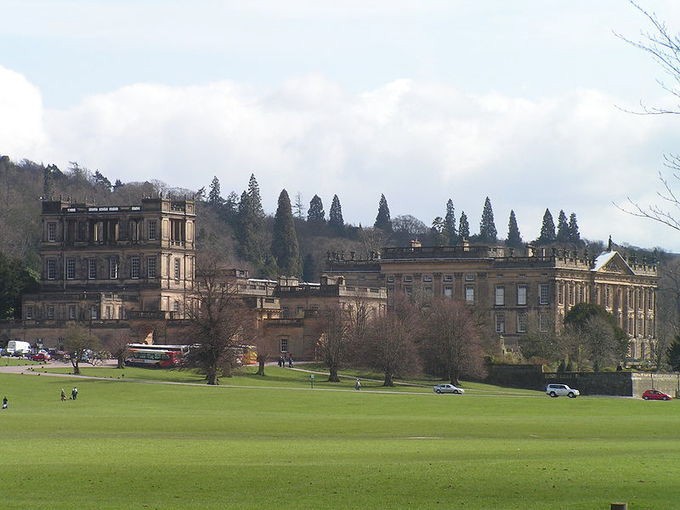
French Architecture in the Baroque Period: Versailles
The Palace of Versailles was built during King Louis XIV’s reign and contains 700 rooms, extensive gardens, and lavish decoration.
Learning Objectives
- Identify the most impressive features of Versailles and those artistically responsible.
Key Points
- The Palace of Versailles was executed in the French Baroque style, characterized by its large curved forms, twisted columns, high domes, and complicated shapes.
- The architect for the palace was Louis Le Vau, the interior decorator was Charles Le Brun, and the landscape designer was Andre Le Notre.
- Interior design from this period is known as Louis XIV style. Originated by Le Brun, it is characterized by richly woven red and gold fabrics or brocades, heavy gilded plaster molding, large sculpted side boards, and heavy marbling.
- The gardens at Versailles cover nearly 2,000 acres of land and were executed in the French formal garden style, or jardin a la francaise.
- Notable features of the palace include the Hall of Mirrors and the Grande Canal.
Key Terms
- parterre: A garden with paths between flowerbeds.
- brocade: A thick, heavy fabric into which raised patterns have been woven.
- molding: A plane or curved narrow surface, either sunk or projecting, used for decoration by means of the lights and shades upon its surface and to conceal joints, especially between unlike materials.
Overview: Versailles
The Palace of Versailles is an opulent palace built by Louis XIV that contains 700 rooms, extensive gardens, and lavish decoration. Initially, a small hunting lodge built by his father, Louis XIV transformed Versailles with four intensive building campaigns over his reign. The formal aesthetic of the palace was meant to glorify France and show the power and greatness of the self-proclaimed Sun King, Louis XIV. The architect for the palace was Louis Le Vau, the interior decorator was Charles Le Brun, and the landscape designer was Andre Le Notre. These three artists had worked together previously on the private Chateau Vaux le Vicomte for the king’s minister of finance before he was imprisoned. In 1682, Versailles was transformed into the official residence of the king, and such notable features of the palace as the Hall of Mirrors and the Grande Canal were built.
The Architecture: Louis Le Vau
The Palace of Versailles was executed in the French Baroque style by architect Louis Le Vau, a French Classical architect who worked for King Louis XIV. French Baroque architectural style is characterized by its large curved forms, twisted columns, high domes, and complicated shapes. In comparison to the Baroque architecture of the rest of Europe, it is commonly thought to be more restrained and characterized by its mixture of lavish details on symmetrical and orderly buildings.
The Interior Design: Charles Le Brun
Charles Le Brun was the interior decorator for the Palace of Versailles, as well as first painter to the king. Louis XIV declared Le Brun the “greatest painter of all time,” and Le Brun worked on such notable features of the palace as the Halls of War and Peace, the Ambassadors’ Staircase, and the Great Hall of Mirrors. Interior design from this period is known as Louis XIV style, originated by Le Brun, and was characterized by richly woven red and gold fabrics or brocades, heavy gilded plaster molding, large sculpted side boards, and heavy marbling.
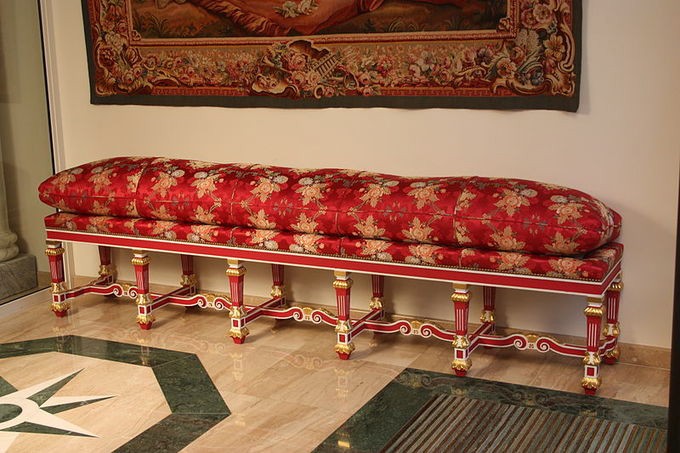
The Hall of Mirrors is the central gallery of the Palace of Versailles and is one of the most famous rooms in the world. The main feature of this room is a series of 17 mirrored arches that reflect 17 arcaded windows overlooking the gardens. Each arch contains 21 mirrors. The arches are fixed between marble pilasters upon which bronze symbols of France are embedded.
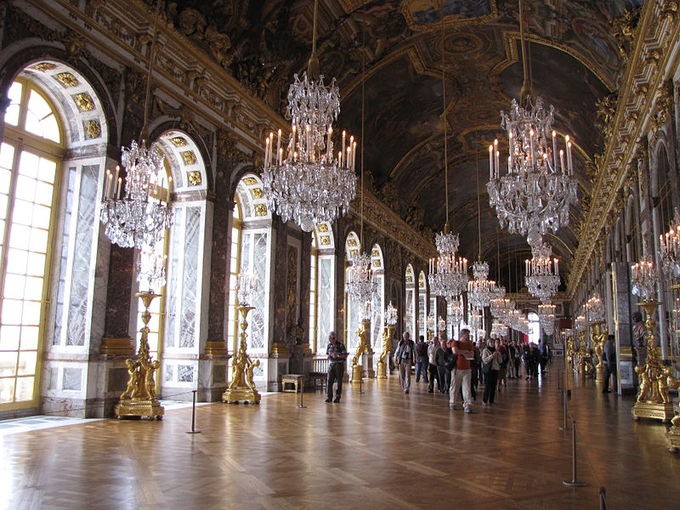
The Gardens: Andre Le Notre
The landscape design at the Palace of Versailles is one of the most extravagant in history. Headed by Andre Le Notre, the gardens at Versailles cover nearly 2,000 acres of land and were executed in the French formal garden style, or jardin a la francaise. This style is characterized by its meticulously manicured lawns, parterres of flowers, numerous fountains, and sculptures.
A common feature of sculpture and decoration at Versailles is the use of classical mythology as allegory. The Bassin de Latone (Basin of the Pool) was designed by Le Notre and sculpted by Gaspard and Balthazar Marsy between 1668–1670. (https://fr.wikipedia.org/wiki/Fichier:Bassin_de_Latone_2016.jpg)
This fountain depicts scenes from Ovid’s Metamorphoses, chosen as allegories to revolts during the king’s reign. The Bassin d’Apollon is another fountain that depicts the sun god driving his chariot to light the sky. The Grotte de Thetys is a freestanding structure with an interior decorated in elaborate shell-work to represent the myth of Apollo.
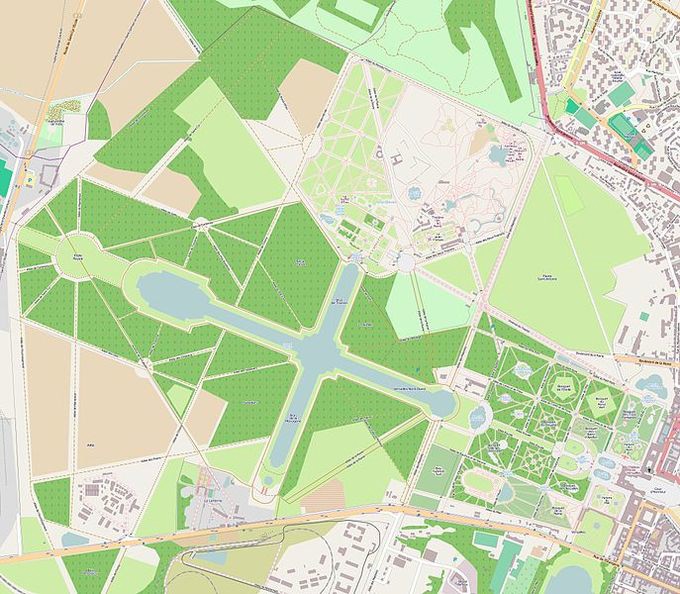
The Grande Canal is a notable feature of the gardens, with an impressive length of 1,500 x 62 meters. King Louis XIV ordered the construction of “little Venice ” on the Grand Canal, which housed yachts, gondolas, and gondoliers received from Venice. It also served a functional purpose by gathering the water that drained from the fountains and redistributing it to the gardens by horse-powered pump.

